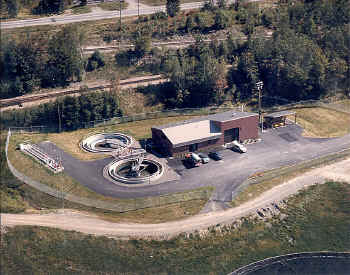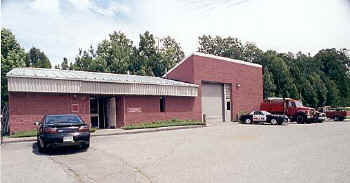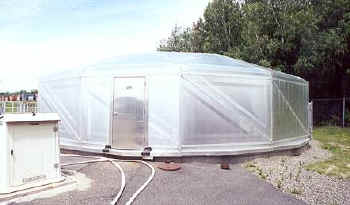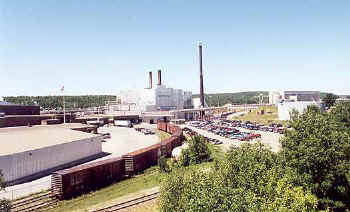East Millinocket Water and Sewer Department
53 Maine St.
East Millinocket, Maine 04430

The East Millinocket Wastewater
Treatment Facility was built in 1984 by the Charwell Construction Company
and engineered by CDM. The facility went online in 1985. The plant
provides primary treatment by clarification. The facility’s effluent is
treated with chlorine to control bacteria prior to discharging it to the
aeration basin at the adjacent wastewater treatment facility for the Great
Northern Paper Company. GNP wastewater treatment facility discharges
secondary treated effluent to the Penobscot River. There are two duplex
pump stations in the 15 miles of collection system, one of which serves an
industrial park within the town limits.

East Millinocket Treatment Plant
The EMWWTF has an average
daily flow of 0.366 mgd. In 1997 the plant averaged a BOD loading of 247
lbs/day and a TSS loading of 94 lbs/day to GNP’s aeration basin. It
produces approximately 220 cubic yards of sludge per year at between 18%
to 20% solids. The treated biosolids are spread on farmlands in the
adjacent town of Medway. The flow consists of domestic sanitary and
commercial wastewater. There are no industrial waste streams received at
the treatment plant as the GNP paper mill has its own treatment facility.
There are 796 residential sewer connections to the system. Septage is
taken at the treatment plant from East Millinocket residents only.
With a current quarterly rate of $36.00 per 1,200 cubic feet
minimum, there has never been a sewer rate increase in the town of East
Millinocket since the facility went online.

click image for larger size
Reinforced Aluminum Clarifier
Cover
Early upgrades to the system
included placing fiberglass dome covers on top of the two clarifiers. When
in 1998 one of the covers collapsed, it was replaced with a new cover
which was constructed with reinforced aluminum. The other existing dome
was extensively reinforced to maintain its structural integrity.
Within
the 15 miles of collection system pipes range in sizes from 6-inch sewer
services to an 18-inch trunk sewer. There are approximately 207 manholes
within the system. The majority of the sewer system is constructed of
vitrified clay or asbestos pipe with many of the newer area in the system
being constructed of PVC pipe.
The facility began experiencing cso’s early in its existence. The
majority of the collection system was designed and installed by the Great
Northern Paper Company some 50 years ago. Over the years the collection
system has experienced hydraulic capacity problems due to growth in the
community. This limited hydraulic capacity resulted in problems including
surcharging of wastewater into homes and overflows of wastewater into the
Penobscot River. In 1996 the Town submitted a Wet Weather Flow Management
Plan to the DEP identifying a schedule to reduce inflow and infiltration
to the sewer system and reduce the number of overflow occurrences to the
Penobscot River. In 1997 an
engineering firm was hired to perform a town wide Sewer System Study
Evaluation (SSES) in 1997. The entire town was smoke and dye tested as
well as a complete manhole flow study performed. This study identified a
lot of the cso problems and as a result corrective action ensued. In 1998
the town took the first step in reducing its overflows to the Penobscot
River by increasing the diameter of the flow metering piping and flow
meter to allow for a higher flow to be sent to the GNP wastewater
treatment facility. To date there have been no cso’s since 1998. The
Town will be removing several more inflow sources to the sewer system and
a target date of the year 2005 has been set to end all cso activity. These
improvements will comply with the Town’s Wet Weather Management Flow
Program and eliminate discharges to the Penobscot River.
Water Well Pump Houses
Hathaway Farm

The majority of the town’s
underground water distribution system was designed and installed by the
Great Northern Paper Company some 50 years ago. The town of East
Millinocket purchased the water utility from General Waterworks, a
Philadelphia base water conglomerate, in 1979. The well system pumps an
average of 600,000 gallons per day to 861 service connections. Of this
total flow, 73% travels to the Great Northern Paper Company on a daily
basis.

Great Northern Paper Company in East
Millinocket, Maine
The
town had the foresight to borrow additional monies when they bought the
utility to perform extensive upgrades to the system. Since the town has
taken over the waterworks they have replaced / upgraded 55 of the 110
hydrants in the system. All three pump houses, which sit on an aquifer at
the Hathaway Farm, have been revamped. In 1988 the number 3 pump house was
raised 12 feet up from the ground level and a berm was constructed around
it. This was done to help keep out the ice and high water from spring
floods on the East Branch of the Penobscot River. This pump house serves
as the emergency back up for the system in the event of extended power
outages. It contains a 453 Detroit Diesel engine coupled to a right angle
drive of a Worthington pump with an output of 1,450 gpm. This is more than
the other 2 pump houses combined. The residential water metering system
was upgraded to 100% outside readers and is now being changed over to a
touch pad system. In 1981 a new standpipe was constructed by Chicago
Bridge and Iron. The older 200,000-gallon standpipe was replaced with a
new 1.2 million gallon structure.
With a rate of $25.80 per 1,200 cubic feet,
the town last saw a rate increase in 1993.
In 1997 an engineering firm was hired to
help with distribution studies for the Main Street and Industrial Park
area. Due to the small size of the water main along Main St., the existing
supply line is not adequate to provide water flow or fire protection needs
for the Industrial Park area. The replacement of the water mains is
scheduled for later this summer as part of a one million dollar upgrade.
The existing 1,200 feet of 6-inch line has been identified as a water
supply bottleneck and will be replaced with new 12-inch ductile iron pipe.
Two new fire hydrants will also be added. Also included in this project
will be radio telemetry systems for the water storage tank, and water pump
stations #1, #2, and #3. It is also proposed to conduct a complete water
system analysis as well as conducting flow and pressure tests. The data
would be used to calibrate the hydraulic model of the system.
|